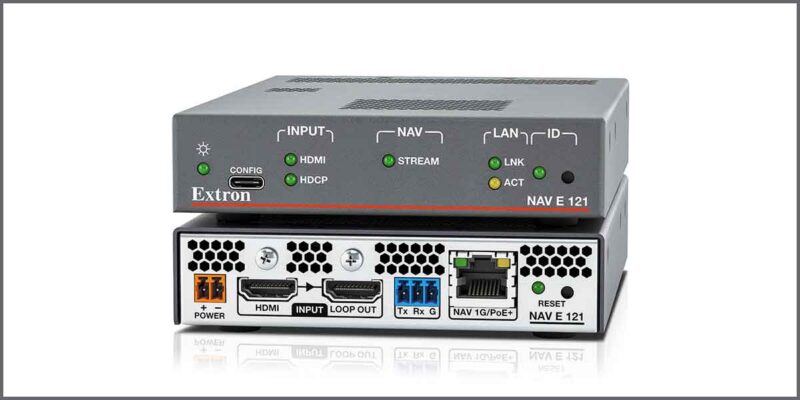AV Over IP Sales Up Over 130 in 2017
 AV over IP is poised to eventually revolutionize the low-latency Pro AV market, according to a newly-released industry report from Futuresource Consulting. Moving from a position of relative obscurity, AV over IP encoder/decoder ports will enjoy a year-on-year increase of over 130 percent.
AV over IP is poised to eventually revolutionize the low-latency Pro AV market, according to a newly-released industry report from Futuresource Consulting. Moving from a position of relative obscurity, AV over IP encoder/decoder ports will enjoy a year-on-year increase of over 130 percent.
AV over IP describes the distribution of video over an IP network within an enterprise, hospital or campus at low latencies. Traditionally, the distribution of video from multiple sources to multiple endpoints such as displays, projectors and monitors has required a matrix switcher; a large and costly piece of hardware.
Although we agree with most of what Futuresource is saying here below, we believe it will be a slower transition to acceptance. And, until both Extron and Crestron have a complete line of AV-over-IP products, most of the ProAV integration community will go slowly adopting this new way of signal routing. Don’t underestimate this impact. But, once you see both of those companies out with a FAMILY or products — not just one line — then you’ll see rapid adoption.
“This is a game changer for the industry and its impact cannot be overstated,” says Anthony Brennan, research analyst at Futuresource Consulting. “We’re seeing the beginnings of a trend that will shake up the industry, with our forecasts pointing to a volume CAGR of nearly 50 percent during the next five years. Make no mistake, AV over IP will transform the way the Pro AV market interacts with and controls AV systems.”
Until recently, AV over IP solutions were considered unrealistic in low-latency Pro AV applications, but they are now competing directly with established technologies and forcing the global matrix switcher market into a period of decline.
“The matrix switcher market is well established,” says Brennan, “and with high barriers to entry it has been monopolized by a handful of large companies. The low barriers associated with AV over IP are allowing smaller companies to compete directly with these large enterprises, merging the worlds of IT and AV, placing software solutions at the heart of the AV industry and fostering innovation and competition. For savvy vendors equipped with the right market information, the scale of the opportunity is enormous.”
From signal distribution brands to IT software and infrastructure players and the wider Pro AV community, the effects of this transition are far-reaching. Furthermore, the threat to established vendors is being amplified by their investments in AV over IP.
“The major signal distribution and control players have tough decisions to make,” adds Brennan. “They must risk cannibalizing their own core businesses by wholesale investment in AV over IP or fall by the wayside as the new Pro AV land grab takes hold.”
Futuresource expects AV over IP solutions to see rapid adoption across most industry verticals, including corporate, education, government, and leisure and hospitality with varying adoption levels in healthcare and residential markets. Short-term, entertainment and higher education applications are forecast to see the highest levels of penetration.
“We’re hearing from vendors that their conversations with users have shifted to the benefits of individual products and competitive advantage,” comments Brennan. “They no longer need to convince users that IP technology is a viable option for low latency signal distribution. This represents a significant shift in mindset for the wider AV world.
“This is a game changer for the industry and its impact cannot be overstated,” says Anthony Brennan, research analyst at Futuresource Consulting. “We’re seeing the beginnings of a trend that will shake up the industry, with our forecasts pointing to a volume CAGR of nearly 50 percent during the next five years. Make no mistake, AV over IP will transform the way the Pro AV market interacts with and controls AV systems.”
Until recently, AV over IP solutions were considered unrealistic in low-latency Pro AV applications, but they are now competing directly with established technologies and forcing the global matrix switcher market into a period of decline.
“The matrix switcher market is well established,” says Brennan, “and with high barriers to entry it has been monopolized by a handful of large companies. The low barriers associated with AV over IP are allowing smaller companies to compete directly with these large enterprises, merging the worlds of IT and AV, placing software solutions at the heart of the AV industry and fostering innovation and competition. For savvy vendors equipped with the right market information, the scale of the opportunity is enormous.”
From signal distribution brands to IT software and infrastructure players and the wider Pro AV community, the effects of this transition are far-reaching. Furthermore, the threat to established vendors is being amplified by their investments in AV over IP.
“The major signal distribution and control players have tough decisions to make,” adds Brennan. “They must risk cannibalizing their own core businesses by wholesale investment in AV over IP or fall by the wayside as the new Pro AV land grab takes hold.”
Futuresource expects AV over IP solutions to see rapid adoption across most industry verticals, including corporate, education, government, and leisure and hospitality with varying adoption levels in healthcare and residential markets. Short-term, entertainment and higher education applications are forecast to see the highest levels of penetration.
“We’re hearing from vendors that their conversations with users have shifted to the benefits of individual products and competitive advantage,” comments Brennan. “They no longer need to convince users that IP technology is a viable option for low latency signal distribution. This represents a significant shift in mindset for the wider AV world.





